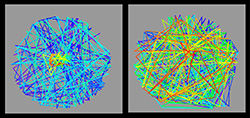Olfactory Fine-Tuning Helps Fruit Flies Find Their Mates
July 30, 2008
By Susan Brown
Fruit flies fine-tune their olfactory systems by recalibrating the sensitivity of different odor channels in response to changing concentrations of environmental cues, a new study has shown. Disable this calibration system, and flies have trouble finding a mate, the researchers found.

Normal fruit flies (left) quickly found a female at the center of the testing arena, whilst flies unable to calibrate their olfactory systems (right) wandered aimlessly. Track color depicts time beginning with violet and ending with red.
Credit: Cory Root/UCSD
Just like overly bright light can wash out a photographic image, strong smells can overwhelm the olfactory system and eliminate an animal's ability to detect subtle differences, such as changes in concentration that would allow it to track a scent.
Now neurobiologists at UC San Diego, Stockholm University and the National Institute of Child Health and Human Development have evidence that the fly nervous system can dampen its response to intense smells to prevent strong signals from overloading the circuits, they report in the July 31 issue of Neuron.
"We found a feedback mechanism in the olfactory system," said Jing Wang, assistant professor of biology at UCSD and senior author of the paper. "This system may be useful for the fly to navigate the olfactory landscape. Odor concentrations can change very dramatically, and this is how they deal it."
Chemical Calibration
Olfactory neurons selectively respond to particular chemicals, such as ethyl hexanoate, which smells like ripe bananas, or food to a fruit fly.
"We applied natural odors to the antennae, odors that the fly would normally smell," said Cory Root, a graduate student in biology at UCSD and first author of the paper.
When Root wafted concentrated banana smell onto the flies' antennae, he found increases in signaling by a molecule called the GABAB receptor, which helps to inhibit neurons from sending signals, and he confirmed that cells with increased signaling by GABAB receptors released neurotransmitter less easily.
Other strong fruity smells and a male pheromone, a chemical sex attractant, also shifted subsequent neural responses to those stimulants, adjusting the response range to detect differences between higher levels of these odors.
But carbon dioxide, a stress signal in flies, shifted the response very little. "It's like evolution has taken advantage of the system to adjust some channels up and down without affecting other channels," Wang said. "If you want high sensitivity to CO2 then you can eliminate the feedback receptor in those neurons. For other odors such as pheromone, which is important for finding other flies, a good tracking system is needed."
Sensory Overload
When the team knocked down levels of the receptor molecule within the specific olfactory neurons tuned to pheromones using molecular biological techniques they found that the fly neural system failed to adjust to chemical overloads. And without the fine tuning, male flies had difficulty finding females.
Most normal flies let loose in an area with an immobilized female quickly locate her and attempt to mate, even in the dark. But when Root and colleagues disabled the calibration system, most males wandered aimlessly.
"Flies that lack inhibition in their pheromone sensing neurons often fail to find the female," Root said. "The control flies are strikingly different. Soon after they get accustomed to the new arena they zoom in on the female and immediately start courting her."
Only half as many of the disabled flies he tested made contact with the female within the 30 minute testing period, despite being confined to a plastic dish only 40 millimeters wide.
The Whitehall Foundation and the National Institute for Deafness and Other Communication Disorders funded this research. Jing Wang is a Beckman investigator, Hellman faculty scholar and Searle Scholar.
